
My first advertising job was as a contract author for an company on the alternative facet of the world. This additionally occurred to be my first “actual” job and, consequently, my first expertise of distant work.

Since then, I’ve labored with a number of different corporations throughout a number of time zones and, in consequence, skilled the whole lot distant work has to supply — from the challenges of establishing a house workplace to the thrill of location independence.
However extra importantly, I’ve additionally gotten to consciously observe the expansion and affect of distant work over time.

On this publish, I’ll be sharing 60 statistics that will help you perceive the evolution, alternatives, and challenges this distinctive mode of labor presents.
Every part is designed to supply extra than simply statistics and as an alternative give you a cohesive, research-backed narrative on every sub-topic.
Desk of Contents
The Introduction and Evolution of Distant Work
- In line with Hubspot, the most well-liked work mannequin right now is a hybrid mannequin, which is most popular by 41% of staff. That is adopted by the absolutely distant work mannequin (32%), and, lastly, on-site work (27%). Nevertheless, curiously, earlier than 2020, most staff had absolutely on-site jobs with no fast plans to modify to different fashions. So, what modified?
- The 2020 lockdown mandated a whole shift to distant work throughout most industries, introducing many to distant work for the primary time. Consequently, an Owl Labs survey discovered that this expertise led to 70% of staff wanting to keep up a hybrid or distant working association even post-pandemic.
- By 2021, an Accenture examine discovered that 83% of world employees seen this hybrid mannequin of labor (a mixture of distant and on-site work) as very best.
- As time went on, employee preferences saved evolving. A 2022 examine discovered that the popular working types shifted a bit from the earlier yr. Distant work was favored by 34% in 2021 however dropped to 29% in 2022. Hybrid work went from 31% to 36%, and in-office work went from 29% to 22%.
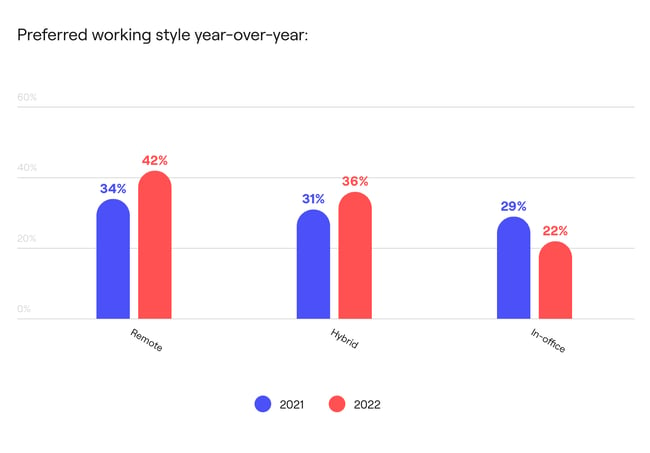 Picture Supply
Picture Supply
- Breaking it down by gender, girls appeared to favor distant work extra (46%) over males (39%). Alternatively, in-office work appeared extra interesting to males, with 24% preferring it in comparison with 19% of girls.
- This examine additionally discovered that round 29% of employees modified jobs, with distant employees being twice as probably (37%) to modify in comparison with these working in an workplace (21%). The highest causes for altering jobs had been higher pay (84%), higher profession alternatives (82%), and higher work/life steadiness (78%).
- However what was much more attention-grabbing was that in line with contributors within the examine, if the choice to work remotely of their present jobs was taken away, 66% stated they’d begin on the lookout for a job that provided extra flexibility, whereas 39% stated they’d merely give up.
- Equally, one other 2022 survey discovered that 63% of employees would select a greater work-life steadiness over higher pay.
- And these sentiments weren’t short-term. A 2022 examine by Buffer discovered that 98% of respondents needed to work remotely in some capability for the remainder of their careers.
- Equally, one other examine discovered that 88% of employees thought of hybrid work as a number one profit they’d anticipate in a brand new job.
- Distant work choices had been so positively obtained that only one% of contributors in a examine by Buffer reported having a unfavourable expertise with distant work.
- Moreover, the examine additionally discovered that 98% of distant employees would suggest distant work to others.
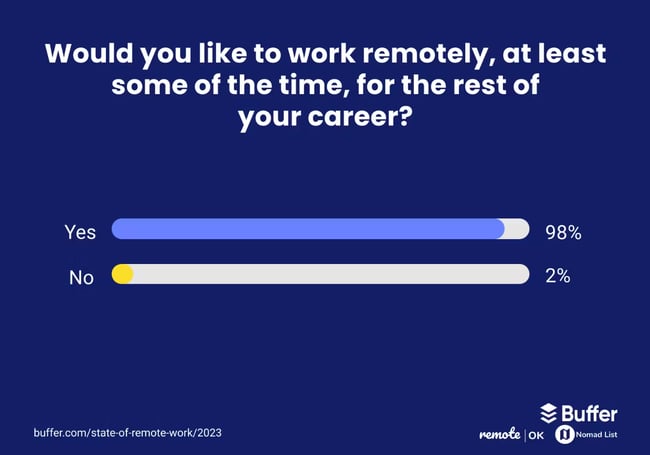 Picture Supply
Picture Supply
- Research proceed to constantly present that many employees choose a distant or hybrid association over on-site work. For example, Atlassian’s State of Work examine confirmed a notable shift within the preferences of distant, office-only, and hybrid employees between 2021 and 2022: 22% in 2022 versus 34% in 2021, 35% in 2022 versus 39% in 2021, and 43% in 2022 versus 27% in 2021, respectively.
- General, the hybrid mannequin of distant work seems to be the comfortable medium between employees and employers, with 45.5% of distant employees having hybrid preparations in comparison with 20.5% who work absolutely from house, in line with a January 2023 survey.
How Firms Have Responded to Distant Work
- Earlier than the 2020 shutdown, simply 8% of corporations had versatile office insurance policies.
- By 2021, almost two-thirds (62%) had applied some degree of versatile work. Mid-size corporations (501-5,000 staff) particularly, had been notably proactive, with 70% implementing versatile work insurance policies.
- Nevertheless, employer sentiments towards distant work continued to evolve. That very same yr, a report by OwlLabs discovered that 73% of those that labored from house through the pandemic finally returned to the workplace not less than someday every week.
- In actuality, whereas 74% of corporations promised some degree of flexibility in work schedules on the time, 82% had been additionally planning a return to pre-pandemic work schedules after the lockdown.
- By 2022, the State of Distant Work report discovered that solely 31% of employers had been providing absolutely distant working choices, with 41% of small corporations (10-50 staff) requiring staff to return to the workplace.
- So, the place precisely does that go away us right now? It actually relies on who you ask. On one hand, 58% of contributors in a McKinsey survey reported having the chance to work at home not less than someday every week.

Picture Supply
- Alternatively, a number of research have discovered that distant work is the exception and never the norm. In line with a examine by Accenture, as of 2022, 36% of employees worldwide had returned to a totally on-site work mannequin throughout all industries.
- One other survey by Atlassian additionally revealed that 82% of all data employees had some type of “in-office mandate,” whereas 25% of employees who supposedly had the selection to work remotely nonetheless felt stress to enter the workplace.
- Lastly, a 2022 U.S. Bureau of Labor Statistics survey discovered that solely 27.5% of personal sector companies (2.5 million) had staff teleworking all or among the time.
- So, how can we interpret this seemingly conflicting knowledge? Nicely, all views might have benefit. By analyzing every business individually somewhat than collectively, the info aligns higher.
- The identical examine by the U.S. Bureau of Labor Statistics discovered that skilled and enterprise providers, instructional providers, and wholesale commerce boasted the best proportion of teleworkers at 67.4%, 49%, 46%, and 39%, respectively. This means that distant work alternatives are merely extra prevalent in sure industries, and examine outcomes will usually differ relying on the business surveyed.
Why Employees Choose Distant Work
- For a lot of employees, the attraction of distant work lies in its flexibility. In line with Hubspot’s Hybrid Work Report, 90% of staff are coping with some degree of burnout and imagine that flexibility, particularly in taking day without work, may considerably cut back their stress ranges.
- However flexibility is not nearly whenever you work. In line with findings from a Buffer examine, the largest distant work advantages for employees embody with the ability to handle their time (22%), select the place they dwell (19%), and determine the place they work (13%).
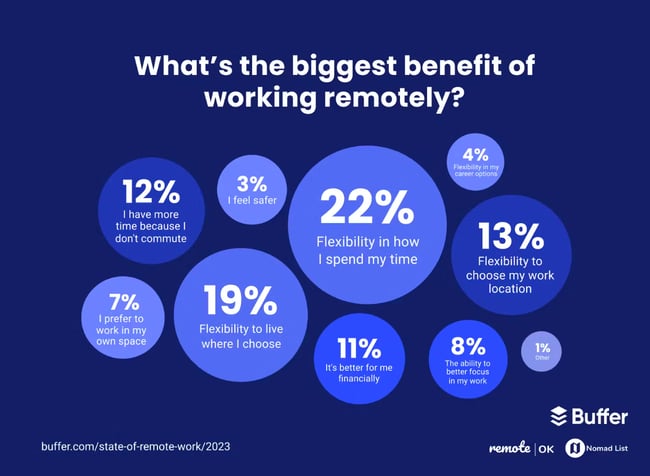
Picture Supply
- Atlassian’s analysis offers additional perception, displaying that the first cause US data employees choose distant work is that they’re merely happier working from house (47%).
- However past happiness and suppleness, distant employees additionally report greater productiveness ranges. In line with a examine by Owl Labs, a big majority (62%) of employees really feel extra productive when working remotely, in comparison with simply 11% who really feel much less productive.
- A Buffer examine additionally discovered that 70% of employees discover it simpler to focus, 65% handle stress higher, and 50% keep away from distractions higher when working remotely.
- Lastly, whereas the workplace is seen as the best atmosphere for sure actions, similar to assembly new folks (59%), managing others (51%), and group conferences (51%), employees are break up on the place they like to innovate and brainstorm. Some thrive within the workplace (39%), whereas others appear to search out their stream higher at house (37%).
The Enterprise Influence of Distant Work
- Distant work, whether or not absolutely distant or hybrid, usually incurs bills that aren’t sometimes related to conventional work fashions. In line with findings from Buffer’s State of Distant Work Report, 64% of staff indicated that their corporations paid for {hardware} similar to screens, whereas 40% reported that their corporations coated prices related to house workplace gear.
- Apparently, house web, which is arguably essentially the most essential distant work device, is just coated by 28% of corporations.
- One other extra distant working price corporations usually must cowl is coworking memberships. 22% of respondents within the Buffer survey indicated that their corporations cowl their memberships, whereas 38% expressed a want for his or her corporations to take action.
- Now, apart from worker bills, companies additionally want to contemplate how distant work may have an effect on profitability. For instance, HubSpot’s 2024 State of Gross sales Report revealed that 46% of salespeople understand promoting remotely as much less efficient than in-person gross sales.
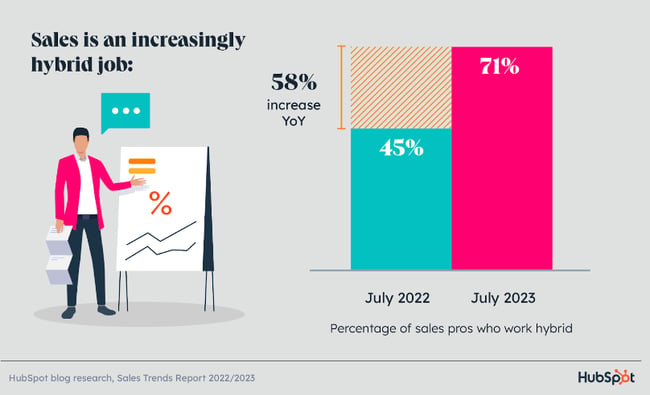
Picture Supply
- So, what does this imply? Is distant work merely an added expense with no actual advantages to the underside line? Quite the opposite, distant work additionally presents main monetary advantages. In line with a examine by IWG, greater than four-fifths of Chief Monetary Officers (CFOs) (82%) imagine that distant work, particularly in a hybrid format, is a more cost effective enterprise mannequin in comparison with conventional workplace setups.
- This line of pondering is supported by findings from International Office Analytics, which means that hybrid working preparations can save organizations greater than $11,000 per worker yearly on common.
- However how precisely does distant work ship price financial savings for corporations? Firstly, there’s the potential for substantial financial savings on workplace hire. The IWG examine discovered that two-thirds (65%) of CFOs intention to scale back facility spending by greater than 10% per yr.
- Equally, one other examine discovered that 60% of U.S. executives plan to scale back workplace house by as much as half or extra.
- The rationale behind these cost-saving measures is obvious. By eliminating or considerably lowering workplace house necessities, corporations can keep away from committing to costly, long-term leases, modify their house necessities as wanted, and luxuriate in enormous price financial savings. For example, Cisco’s adoption of hybrid working practices has resulted in financial savings of $500 million over the previous 5 years.
- However there’s extra to it than simply saving on workplace prices. Employee prices alone reveal an attention-grabbing pattern. An Owl Labs examine discovered that greater than half of all employees (52%) could be prepared to simply accept a pay minimize of 5% or extra in trade for the pliability to decide on their working location. The truth is, 23% indicated they’d settle for a pay minimize of 10% or extra for this profit.
- Conversely, if employees had been not allowed to work remotely or in a hybrid setup, 67% would anticipate a pay enhance to cowl extra commuting bills.
- Lastly, past price concerns, current analysis performed by IWG and Arup revealed that hybrid working has the potential to scale back city carbon emissions by 70% within the UK and as much as 87% within the U.S.. These findings recommend that the environmental affect of absolutely distant work may very well be substantial for companies that select to undertake distant work fashions.
Collaboration in a Distant Work Setting
- In line with a current HubSpot survey, the primary ache level for corporations within the distant work period is disconnected programs. Particularly, the survey discovered that the highest downside for distant corporations appears to be difficulties with communication and collaboration between groups.
- However why is that this an issue? One potential cause may very well be how distributed groups are these days. For instance, Buffer’s State of Distant Work survey discovered that 74% of respondents labored in corporations that function throughout a number of time zones. Moreover, over half of the distant employees (62%) in that examine reported having folks of their fast groups distributed throughout a number of time zones.
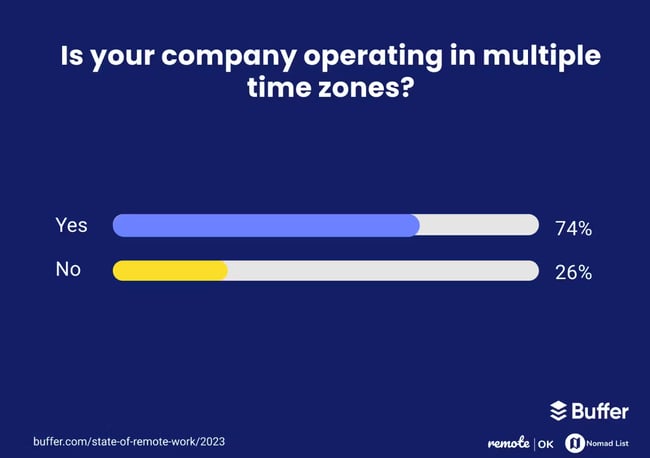
Picture Supply
- This distributed setup impacts how distant groups collaborate. At present, collaboration primarily happens via messaging apps (50%), emails (22%), and conferences (19%), with video calls being the commonest for conferences. Apparently, solely about one-third (36%) of employers have upgraded their video assembly expertise since 2020.
- For digital conferences particularly, a Buffer examine discovered that when taking conferences, most distant employees choose to be on digicam. When requested why, 67% of contributors felt it was simpler to speak after they may see somebody’s expression.
- That stated, not all conferences are seen favorably by distant employees. A examine by HubSpot revealed that 70% of staff discover too many calls and conferences disruptive to their focus. Moreover, 58% really feel that not less than half of the conferences they attend may have been dealt with via emails as an alternative.
- Furthermore, the identical examine additionally discovered that e-mail was the popular communication platform for a majority of respondents (39%) when requested to decide on one platform for the upcoming yr.
- On the facet of the organizations, a number of research have proven that employers are additionally taking measures to make sure seamless collaboration amongst distant groups. A 2022 examine discovered that roughly half (50%) of employers have offered coaching to managers on managing distant and hybrid groups.
- Equally, a HubSpot examine discovered that 32% of staff who participated of their Hybrid Work survey had obtained tips on utilizing unified communication and collaboration instruments. Moreover, 54% had obtained coaching on conducting efficient and inclusive hybrid conferences.
- Lastly, a current examine additionally discovered that 37% of employers have added or elevated using worker monitoring software program, indicating a rising pattern in direction of more practical monitoring and administration of distant groups.
Challenges of Distant Work
- Whereas distant work presents many advantages, it additionally presents a number of challenges. For some distant employees, the wrestle lies within the isolation of staying house too usually. One examine discovered that one in three distant employees reported this as their greatest problem, with loneliness following carefully behind at 23%.
- A 2022 Hubspot survey additionally discovered that 40% of distant employees reportedly miss spontaneous, in-person connections with their colleagues,
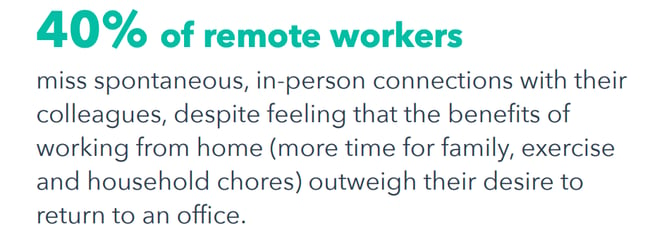
Picture Supply
- There’s additionally the truth that not each worker thrives in a distant atmosphere. A current examine discovered that just about half of U.S. employees really feel their groups don’t operate successfully in a hybrid atmosphere.
- Whereas this might probably be attributed to a number of causes, a 2022 examine discovered that 77% of distant employees who felt much less productive attributed this to elevated distractions at house, which is comprehensible contemplating that 45% of distant employees make the most of multi-purpose areas, similar to bedrooms or kitchens, for work.
- Separating work and private life may also be troublesome in a distant setting. In a single examine, 81% of distant employees admitted to checking work emails exterior of workplace hours, with 63% doing so on weekends and 34% whereas on trip. Furthermore, 48% usually labored past conventional hours, with 44% reporting elevated work hours in comparison with the earlier yr.
- One other examine additionally discovered that just about half (45%) of employees report a rise in work-related stress over the previous yr.
- Lastly, one other main problem for distant work adoption appears to be office perceptions. One examine discovered that 49% of employees really feel that managers view in-office staff as more durable working and extra reliable than distant counterparts.
- Equally, one other examine discovered that 10% of staff concern being perceived as much less productive or dedicated in the event that they work remotely.
Navigating The Distant Work Panorama
Whereas distant work presents new and distinctive challenges, with the appropriate strategy and understanding, it will possibly result in extra productive and satisfying working preparations for each staff and employers.
Whether or not you‘re contemplating your first distant function or hiring distant group members, it’s necessary to maintain the stats above in thoughts because the world continues to evolve and embrace flexibility.

.png)